方波 的傅里叶级数前四项的部分总和。随着增加更多的谐波,这个部分总和收敛成方波。在数学 中,傅里叶级数 (英语:Fourier series ,波 的函数表示成简单谐波 的方式。更正式地说,对于满足狄利克雷定理 的周期函数 ,其傅里叶级数 是由一组正弦 与余弦函数 的加权 和表示的方法。傅里叶级数与用来找出无周期函数的频率信息的傅里叶变换 有密切的关系。
傅里叶级数是傅里叶分析 的一个研究分支,也是采样定理 原始证明的核心。傅里叶级数在数论 、组合数学 、信号 处理、概率论 、统计学 、密码学 、声学 、光学 等领域都有着广泛的应用。
傅里叶级数得名于法国数学家约瑟夫·傅里叶 (1768年–1830年),他提出任何 函数都可以展开 为三角级数 。此前数学家欧拉 、达朗贝尔 和克莱罗 ,已发现在认定一个函数有三角级数展开后,通过积分方法计算其系数的公式,而拉格朗日 等人已经找到了一些非周期函数的三角级数展开。将周期函数分解为简单振荡 函数的总和的最早想法,可以追溯至公元前3世纪古代天文学家的均轮和本轮 学说。
傅里叶的工作得到了丹尼尔·伯努利 的赞助[ 1] 热传导方程 ,其最初论文虽经西尔维斯特·拉克鲁瓦 加斯帕尔·蒙日 同意[ 2] 拉格朗日 、拉普拉斯 和勒让德 评审后被拒绝出版,他的现在被称为傅里叶逆转定理 [ 3]
上图展示了蓝色无周期函数
s
(
x
)
{\displaystyle s(x)}
[
0
,
P
]
{\displaystyle [0,P]}
s
(
x
)
{\displaystyle s(x)}
傅里叶级数可以用不同的形式来表达,下面将周期 为
P
{\displaystyle P}
周期函数
s
(
x
)
,
x
∈
R
{\textstyle s(x),\ x\in \mathbb {R} }
人们常用
sin
(
x
)
{\displaystyle \sin(x)}
cos
(
x
)
{\displaystyle \cos(x)}
三角级数 来表示
s
(
x
)
{\textstyle s(x)}
n
{\displaystyle n}
谐波
sin
(
2
π
n
x
P
)
{\textstyle \sin({\frac {2\pi nx}{P}})}
cos
(
2
π
n
x
P
)
{\textstyle \cos({\frac {2\pi nx}{P}})}
s
(
x
)
{\textstyle s(x)}
权重 ,求得它们的总和 ;这些
n
{\displaystyle n}
傅里叶级数系数
A
0
=
1
P
∫
P
s
(
x
)
d
x
A
n
=
2
P
∫
P
s
(
x
)
cos
(
2
π
n
x
P
)
d
x
for
n
≥
1
B
n
=
2
P
∫
P
s
(
x
)
sin
(
2
π
n
x
P
)
d
x
for
n
≥
1
{\displaystyle {\begin{aligned}A_{0}&={\frac {1}{P}}\int _{P}s(x)\,dx\\A_{n}&={\frac {2}{P}}\int _{P}s(x)\cos \left({\frac {2\pi nx}{P}}\right)\,dx\qquad {\text{for }}n\geq 1\qquad \\B_{n}&={\frac {2}{P}}\int _{P}s(x)\sin \left({\frac {2\pi nx}{P}}\right)\,dx\qquad {\text{for }}n\geq 1\end{aligned}}}
Eq.1
符号
∫
P
{\textstyle \int _{P}}
区间 上的积分,典型的选择为
[
−
P
/
2
,
P
/
2
]
{\displaystyle [-P/2,P/2]}
[
0
,
P
]
{\displaystyle [0,P]}
A
0
{\displaystyle A_{0}}
s
(
x
)
{\displaystyle s(x)}
平均值 [ A] 傅里叶变换 。
通过这些系数定义傅里叶级数为:
傅里叶级数,正弦-余弦形式
s
(
x
)
∼
A
0
+
∑
n
=
1
∞
(
A
n
cos
(
2
π
n
x
P
)
+
B
n
sin
(
2
π
n
x
P
)
)
{\displaystyle s(x)\sim A_{0}+\sum _{n=1}^{\infty }\left(A_{n}\cos \left({\frac {2\pi nx}{P}}\right)+B_{n}\sin \left({\frac {2\pi nx}{P}}\right)\right)}
Eq.2
这里使用符号
∼
{\displaystyle \sim }
s
(
x
)
{\displaystyle s(x)}
n
{\displaystyle n}
x
{\displaystyle x}
s
(
x
)
{\textstyle s(x)}
Eq. 2
∼
{\displaystyle \sim }
=
{\displaystyle =}
在傅里叶级数系数中的整数索引
n
{\displaystyle n}
cos
{\displaystyle \cos }
sin
{\displaystyle \sin }
周期
P
{\displaystyle P}
圆周 (cycle)的数目。因此对应于
A
n
{\displaystyle A_{n}}
B
n
{\displaystyle B_{n}}
波长 等于
P
n
{\displaystyle {\tfrac {P}{n}}}
x
{\displaystyle x}
频率 等于
n
P
{\displaystyle {\tfrac {n}{P}}}
x
{\displaystyle x}
下面借由欧拉公式
e
i
x
=
cos
x
+
i
sin
x
{\displaystyle \ e^{ix}=\cos x+i\sin x\ }
复数 指数 形式。
根据定义,我们可以得到:
复数傅里叶级数系数
c
0
=
A
0
c
n
=
(
A
n
−
i
B
n
)
/
2
for
n
>
0
c
n
=
(
A
−
n
+
i
B
−
n
)
/
2
for
n
<
0
{\displaystyle {\begin{aligned}c_{0}&=A_{0}&\\c_{n}&=(A_{n}-iB_{n})/2\qquad &{\text{for }}n>0\\c_{n}&=(A_{-n}+iB_{-n})/2\qquad &{\text{for }}n<0\end{aligned}}}
Eq. 3
通过将等式Eq. 1 Eq. 3 [ 4]
复数傅里叶级数系数
c
n
=
1
P
∫
P
s
(
x
)
e
−
2
π
i
n
x
P
d
x
for
n
∈
Z
{\displaystyle c_{n}={\frac {1}{P}}\int _{P}s(x)e^{-{\frac {2\pi inx}{P}}}\,dx\qquad {\text{for}}\ n\in \mathbb {Z} }
给定复数傅里叶级数系数,可以用公式复原出
A
n
{\displaystyle A_{n}}
B
n
{\displaystyle B_{n}}
复数傅里叶级数系数
A
0
=
c
0
A
n
=
c
n
+
c
−
n
for
n
>
0
B
n
=
i
(
c
n
−
c
−
n
)
for
n
>
0
{\displaystyle {\begin{aligned}A_{0}&=c_{0}&\\A_{n}&=c_{n}+c_{-n}\qquad &{\textrm {for}}~n>0\\B_{n}&=i(c_{n}-c_{-n})\qquad &{\textrm {for}}~n>0\end{aligned}}}
通过这些定义,傅里叶级数可以写为:
傅里叶级数,指数形式
s
(
x
)
∼
∑
n
=
−
∞
∞
c
n
⋅
e
2
π
i
n
x
P
{\displaystyle s(x)\sim \sum _{n=-\infty }^{\infty }c_{n}\cdot e^{\frac {2\pi inx}{P}}}
Eq. 4
这是可推广到复数值域 函数的惯用形式。
n
{\displaystyle n}
负频率 。
人们习惯将
s
(
x
)
{\textstyle s(x)}
值域 普遍化到复数 上,设
s
(
x
)
{\textstyle s(x)}
s
(
x
)
=
Re
(
s
(
x
)
)
+
i
⋅
Im
(
s
(
x
)
)
,
x
∈
R
{\displaystyle s(x)=\operatorname {Re} (s(x))+i\cdot \operatorname {Im} (s(x)),\quad x\in \mathbb {R} }
定义
c
n
≜
c
R
n
+
i
⋅
c
I
n
{\displaystyle c_{n}\triangleq c_{_{Rn}}+i\cdot c_{_{In}}}
c
n
=
1
P
∫
P
s
(
x
)
⋅
e
−
i
2
π
p
n
x
d
x
=
1
P
∫
P
Re
(
s
(
x
)
)
⋅
e
−
i
2
π
p
n
x
d
x
+
i
⋅
1
P
∫
P
Im
(
s
(
x
)
)
⋅
e
−
i
2
π
p
n
x
d
x
{\displaystyle c_{n}={\frac {1}{P}}\int _{P}s(x)\cdot e^{-i{\tfrac {2\pi }{p}}nx}\ dx={\frac {1}{P}}\int _{P}\operatorname {Re} (s(x))\cdot e^{-i{\tfrac {2\pi }{p}}nx}\ dx+i\cdot {\frac {1}{P}}\int _{P}\operatorname {Im} (s(x))\cdot e^{-i{\tfrac {2\pi }{p}}nx}\ dx}
c
R
n
=
1
P
∫
P
Re
(
s
(
x
)
)
⋅
e
−
i
2
π
p
n
x
d
x
{\displaystyle c_{_{Rn}}={\frac {1}{P}}\int _{P}\operatorname {Re} (s(x))\cdot e^{-i{\tfrac {2\pi }{p}}nx}\ dx}
c
I
n
=
1
P
∫
P
Im
(
s
(
x
)
)
⋅
e
−
i
2
π
p
n
x
d
x
{\displaystyle c_{_{In}}={\frac {1}{P}}\int _{P}\operatorname {Im} (s(x))\cdot e^{-i{\tfrac {2\pi }{p}}nx}\ dx}
对于这个复数值函数,它的傅里叶级数的实部,是它的实部的傅里叶级数;它的傅里叶级数的虚部,是它的虚部的傅里叶级数:
s
(
x
)
∼
∑
n
=
−
∞
∞
(
c
R
n
+
i
⋅
c
I
n
)
⋅
e
i
2
π
p
n
x
=
∑
n
=
∞
∞
c
R
n
⋅
e
i
2
π
p
n
x
+
i
⋅
∑
n
=
−
∞
∞
c
I
n
⋅
e
i
2
π
p
n
x
{\displaystyle s(x)\sim \sum _{n=-\infty }^{\infty }\left(c_{_{Rn}}+i\cdot c_{_{In}}\right)\cdot e^{i{\tfrac {2\pi }{p}}nx}=\sum _{n=\infty }^{\infty }c_{_{Rn}}\cdot e^{i{\tfrac {2\pi }{p}}nx}+i\cdot \sum _{n=-\infty }^{\infty }c_{_{In}}\cdot e^{i{\tfrac {2\pi }{p}}nx}}
还可以利用三角恒等式
cos
(
α
−
β
)
=
cos
α
cos
β
+
sin
α
sin
β
{\displaystyle \ \cos(\alpha -\beta )=\cos \alpha \cos \beta +\sin \alpha \sin \beta \,}
A
n
⋅
cos
(
2
π
n
P
x
−
φ
n
)
≡
A
n
cos
(
φ
n
)
⏟
a
n
⋅
cos
(
2
π
n
P
x
)
+
A
n
sin
(
φ
n
)
⏟
b
n
⋅
sin
(
2
π
n
P
x
)
{\displaystyle A_{n}\cdot \cos \left(2\pi {\tfrac {n}{P}}x-\varphi _{n}\right)\ \equiv \ \underbrace {A_{n}\cos(\varphi _{n})} _{a_{n}}\cdot \cos \left(2\pi {\tfrac {n}{P}}x\right)+\underbrace {A_{n}\sin(\varphi _{n})} _{b_{n}}\cdot \sin \left(2\pi {\tfrac {n}{P}}x\right)}
然后定义振幅
A
n
≜
a
n
2
+
b
n
2
{\textstyle A_{n}\triangleq {\sqrt {a_{n}^{2}+b_{n}^{2}}}}
相位
φ
n
≜
arctan2
(
b
n
,
a
n
)
{\textstyle \varphi _{n}\triangleq \operatorname {arctan2} (b_{n},a_{n})}
a
n
{\displaystyle a_{n}}
b
n
{\displaystyle b_{n}}
A
n
{\displaystyle A_{n}}
B
n
{\displaystyle B_{n}}
A
0
2
{\displaystyle {\tfrac {A_{0}}{2}}}
s
(
x
)
{\displaystyle s(x)}
平均值
1
P
∫
P
s
(
x
)
d
x
{\textstyle {\frac {1}{P}}\int _{P}s(x)\,dx}
傅里叶级数,振幅-相位形式
s
(
x
)
∼
A
0
2
+
∑
n
=
1
∞
A
n
⋅
cos
(
2
π
n
P
x
−
φ
n
)
{\displaystyle s(x)\sim {\frac {A_{0}}{2}}+\sum _{n=1}^{\infty }A_{n}\cdot \cos \left(2\pi {\tfrac {n}{P}}x-\varphi _{n}\right)}
Eq. 5
在描述傅里叶级数行为的时候,经常会为一个函数
f
(
x
)
{\displaystyle f(x)}
部分求和 算子
S
N
{\displaystyle S_{N}}
[ 5]
S
N
(
f
)
=
∑
n
=
−
N
N
c
n
e
2
π
i
n
x
P
{\displaystyle S_{N}(f)=\sum _{n=-N}^{N}c_{n}e^{\frac {2\pi inx}{P}}}
Eq. 6
这里的
c
n
{\displaystyle c_{n}}
f
{\displaystyle f}
假设
f
(
x
)
{\displaystyle f(x)}
g
(
x
)
{\displaystyle g(x)}
R
{\textstyle \mathbb {R} }
f
(
x
)
{\displaystyle f(x)}
g
(
x
)
{\displaystyle g(x)}
[
−
π
,
π
]
{\displaystyle [-\pi ,\pi ]}
卷积
(
f
∗
g
)
(
x
)
{\displaystyle (f*g)(x)}
(
f
∗
g
)
(
x
)
=
∫
−
π
π
f
(
τ
)
g
(
x
−
τ
)
d
τ
{\displaystyle (f*g)(x)=\int _{-\pi }^{\pi }f(\tau )g(x-\tau )d\tau }
周期为
2
π
{\displaystyle 2\pi }
f
(
x
)
{\displaystyle f(x)}
部分求和 ,可以经由
f
(
x
)
{\displaystyle f(x)}
狄利克雷核
D
n
(
x
)
=
∑
k
=
−
n
n
e
i
k
x
{\textstyle D_{n}(x)=\sum _{k=-n}^{n}e^{ikx}}
卷积 来表示:
S
N
(
f
)
(
x
)
=
∑
n
=
−
N
N
c
n
e
i
n
x
=
∑
n
=
−
N
N
(
1
2
π
∫
−
π
π
f
(
τ
)
e
−
i
n
τ
d
τ
)
⋅
e
i
n
x
=
1
2
π
∫
−
π
π
f
(
τ
)
(
∑
n
=
−
N
N
e
i
n
(
x
−
τ
)
)
d
τ
=
1
2
π
(
f
∗
D
N
)
(
x
)
{\displaystyle {\begin{aligned}S_{N}(f)(x)&=\sum _{n=-N}^{N}c_{n}e^{inx}\\&=\sum _{n=-N}^{N}\left({\frac {1}{2\pi }}\int _{-\pi }^{\pi }f(\tau )e^{-in\tau }d\tau \right)\cdot e^{inx}={\frac {1}{2\pi }}\int _{-\pi }^{\pi }f(\tau )\left(\sum _{n=-N}^{N}e^{in(x-\tau )}\right)d\tau \\&={\frac {1}{2\pi }}(f*D_{N})(x)\end{aligned}}}
s
N
(
x
)
{\displaystyle s_{N}(x)}
[
x
0
,
x
0
+
P
]
{\displaystyle [x_{0},\ x_{0}+P]}
s
(
x
)
{\displaystyle s(x)}
N
→
∞
{\displaystyle N\rightarrow \infty }
无穷和
s
∞
(
x
)
{\displaystyle s_{\infty }(x)}
s
{\displaystyle s}
狄利克雷条件 。参见傅里叶级数的收敛性 弱收敛
s
(
x
)
{\displaystyle s(x)}
不可导 点上,如果我们只取无穷级数中的有限项求和,那么在这些点上会有幅度不随
N
{\displaystyle N}
吉布斯现象 ,一个简单的例子是方波信号 。
在工程 应用中,一般假定傅里叶级数除了在不连续点以外处处收敛,原因是工程上遇到的函数比数学家提供的这个假定的反例表现更加良好。特别地,傅里叶级数绝对收敛 且一致收敛 于
s
(
x
)
{\displaystyle s(x)}
s
(
x
)
{\displaystyle s(x)}
[ 6]
[
x
0
,
x
0
+
P
]
{\displaystyle [x_{0},x_{0}+P]}
平方可积 的,那么此傅里叶级数在几乎处处 的点都收敛于该函数。
一个相同幅度和频率的锯齿波的近似的可视化
另一个分别采用傅里叶级数的前 1, 2, 3, 4 项近似方波的可视化。(可以在这里
[ 7] 看到一个交互式的动画)
符号
c
n
{\displaystyle c_{n}}
s
{\displaystyle s}
s
^
[
n
]
{\displaystyle {\hat {s}}[n]}
S
[
n
]
{\displaystyle S[n]}
s
(
x
)
=
∑
n
=
−
∞
∞
s
^
(
n
)
⋅
e
2
π
i
n
x
/
P
{\displaystyle s(x)=\sum _{n=-\infty }^{\infty }{\hat {s}}(n)\cdot e^{2\pi inx/P}\quad }
s
(
x
)
=
∑
n
=
−
∞
∞
S
[
n
]
⋅
e
i
2
π
n
x
/
P
{\displaystyle s(x)=\sum _{n=-\infty }^{\infty }S[n]\cdot e^{i\,2\pi nx/P}\quad }
在工程上,特别是在变量
x
{\displaystyle x}
频域 表示。经常使用方括号来强调这个函数的定义域是频率 的离散集合。
另一个常用频域表示,使用傅里叶级数系数,调制 像梳子一样的狄拉克采样函数
S
(
f
)
≜
∑
n
=
−
∞
∞
S
[
n
]
⋅
δ
(
f
−
n
P
)
{\displaystyle S(f)\ \triangleq \ \sum _{n=-\infty }^{\infty }S[n]\cdot \delta \left(f-{\frac {n}{P}}\right)}
这里的
f
{\displaystyle f}
x
{\displaystyle x}
f
{\displaystyle f}
赫兹 为单位。采样的间隔为基本频率
1
P
{\displaystyle {\tfrac {1}{P}}}
n
{\displaystyle n}
谐波 )。
s
∞
(
x
)
{\displaystyle s_{\infty }(x)}
逆傅里叶变换
F
−
1
{
S
(
f
)
}
=
∫
−
∞
∞
(
∑
n
=
−
∞
∞
S
[
n
]
⋅
δ
(
f
−
n
P
)
)
e
i
2
π
f
x
d
f
=
∑
n
=
−
∞
∞
S
[
n
]
⋅
∫
−
∞
∞
δ
(
f
−
n
P
)
e
i
2
π
f
x
d
f
=
∑
n
=
−
∞
∞
S
[
n
]
⋅
e
i
2
π
n
x
/
P
≜
s
∞
(
x
)
{\displaystyle {\begin{aligned}{\mathcal {F}}^{-1}\{S(f)\}&=\int _{-\infty }^{\infty }\left(\sum _{n=-\infty }^{\infty }S[n]\cdot \delta \left(f-{\frac {n}{P}}\right)\right)e^{i2\pi fx}\,df\\&=\sum _{n=-\infty }^{\infty }S[n]\cdot \int _{-\infty }^{\infty }\delta \left(f-{\frac {n}{P}}\right)e^{i2\pi fx}\,df\\&=\sum _{n=-\infty }^{\infty }S[n]\cdot e^{i\,2\pi nx/P}\ \ \triangleq \ s_{\infty }(x)\end{aligned}}}
构造出的函数
S
(
f
)
{\displaystyle S(f)}
傅里叶变换 ”,即使一个周期函数的傅里叶积分在这个谐波频率上不收敛[ B]
下表列出常用的周期函数及其傅里叶级数系数。
s
(
x
)
{\displaystyle s(x)}
P
{\displaystyle P}
A
0
{\displaystyle A_{0}}
A
n
{\displaystyle A_{n}}
B
n
{\displaystyle B_{n}}
s
(
x
)
{\displaystyle s(x)}
时域
s
(
x
)
{\displaystyle s(x)}
绘图
频域(正弦-余弦形式)
A
0
A
n
for
n
≥
1
B
n
for
n
≥
1
{\displaystyle {\begin{aligned}&A_{0}\\&A_{n}\quad {\text{for }}n\geq 1\\&B_{n}\quad {\text{for }}n\geq 1\end{aligned}}}
注释
引用
s
(
x
)
=
A
|
sin
(
2
π
P
x
)
|
for
0
≤
x
<
P
{\displaystyle s(x)=A\left|\sin \left({\frac {2\pi }{P}}x\right)\right|\quad {\text{for }}0\leq x<P}
A
0
=
2
A
π
A
n
=
{
−
4
A
π
1
n
2
−
1
n
even
0
n
odd
B
n
=
0
{\displaystyle {\begin{aligned}A_{0}=&{\frac {2A}{\pi }}\\A_{n}=&{\begin{cases}{\frac {-4A}{\pi }}{\frac {1}{n^{2}-1}}&\quad n{\text{ even}}\\0&\quad n{\text{ odd}}\end{cases}}\\B_{n}=&0\\\end{aligned}}}
全波整流正弦
[ 8] :p. 193
s
(
x
)
=
{
A
sin
(
2
π
P
x
)
for
0
≤
x
<
P
/
2
0
for
P
/
2
≤
x
<
P
{\displaystyle s(x)={\begin{cases}A\sin \left({\frac {2\pi }{P}}x\right)&\quad {\text{for }}0\leq x<P/2\\0&\quad {\text{for }}P/2\leq x<P\\\end{cases}}}
A
0
=
A
π
A
n
=
{
−
2
A
π
1
n
2
−
1
n
even
0
n
odd
B
n
=
{
A
2
n
=
1
0
n
>
1
{\displaystyle {\begin{aligned}A_{0}=&{\frac {A}{\pi }}\\A_{n}=&{\begin{cases}{\frac {-2A}{\pi }}{\frac {1}{n^{2}-1}}&\quad n{\text{ even}}\\0&\quad n{\text{ odd}}\end{cases}}\\B_{n}=&{\begin{cases}{\frac {A}{2}}&\quad n=1\\0&\quad n>1\end{cases}}\\\end{aligned}}}
半波整流正弦
[ 8] :p. 193
s
(
x
)
=
{
A
for
0
≤
x
<
D
⋅
P
0
for
D
⋅
P
≤
x
<
P
{\displaystyle s(x)={\begin{cases}A&\quad {\text{for }}0\leq x<D\cdot P\\0&\quad {\text{for }}D\cdot P\leq x<P\\\end{cases}}}
A
0
=
A
D
A
n
=
A
n
π
sin
(
2
π
n
D
)
B
n
=
2
A
n
π
(
sin
(
π
n
D
)
)
2
{\displaystyle {\begin{aligned}A_{0}=&AD\\A_{n}=&{\frac {A}{n\pi }}\sin \left(2\pi nD\right)\\B_{n}=&{\frac {2A}{n\pi }}\left(\sin \left(\pi nD\right)\right)^{2}\\\end{aligned}}}
0
≤
D
≤
1
{\displaystyle 0\leq D\leq 1}
s
(
x
)
=
A
x
P
for
0
≤
x
<
P
{\displaystyle s(x)={\frac {Ax}{P}}\quad {\text{for }}0\leq x<P}
A
0
=
A
2
A
n
=
0
B
n
=
−
A
n
π
{\displaystyle {\begin{aligned}A_{0}=&{\frac {A}{2}}\\A_{n}=&0\\B_{n}=&{\frac {-A}{n\pi }}\\\end{aligned}}}
锯齿函数
[ 8] :p. 192
s
(
x
)
=
A
−
A
x
P
for
0
≤
x
<
P
{\displaystyle s(x)=A-{\frac {Ax}{P}}\quad {\text{for }}0\leq x<P}
A
0
=
A
2
A
n
=
0
B
n
=
A
n
π
{\displaystyle {\begin{aligned}A_{0}=&{\frac {A}{2}}\\A_{n}=&0\\B_{n}=&{\frac {A}{n\pi }}\\\end{aligned}}}
反锯齿函数
[ 8] :p. 192
s
(
x
)
=
4
A
P
2
(
x
−
P
2
)
2
for
0
≤
x
<
P
{\displaystyle s(x)={\frac {4A}{P^{2}}}\left(x-{\frac {P}{2}}\right)^{2}\quad {\text{for }}0\leq x<P}
A
0
=
A
3
A
n
=
4
A
π
2
n
2
B
n
=
0
{\displaystyle {\begin{aligned}A_{0}=&{\frac {A}{3}}\\A_{n}=&{\frac {4A}{\pi ^{2}n^{2}}}\\B_{n}=&0\\\end{aligned}}}
反全波整流
[ 8] :p. 193
下表展示在时域中的一些数学运算及其对应的在傅里叶级数系数上的效果。
复数共轭 指示为上标星号
∗
{\displaystyle \ ^{*}\ }
s
(
x
)
{\displaystyle s(x)}
r
(
x
)
{\displaystyle r(x)}
P
{\displaystyle P}
x
∈
[
0
,
P
]
{\displaystyle x\in [0,P]}
S
[
n
]
{\displaystyle S[n]}
R
[
n
]
{\displaystyle R[n]}
s
{\displaystyle s}
r
{\displaystyle r}
性质
时域
频域(指数形式)
注释
引用
线性
a
⋅
s
(
x
)
+
b
⋅
r
(
x
)
{\displaystyle a\cdot s(x)+b\cdot r(x)}
a
⋅
S
[
n
]
+
b
⋅
R
[
n
]
{\displaystyle a\cdot S[n]+b\cdot R[n]}
a
,
b
∈
C
{\displaystyle a,b\in \mathbb {C} }
时间反转/频率反转
s
(
−
x
)
{\displaystyle s(-x)}
S
[
−
n
]
{\displaystyle S[-n]}
[ 9] :p. 610
时间共轭
s
∗
(
x
)
{\displaystyle s^{*}(x)}
S
∗
[
−
n
]
{\displaystyle S^{*}[-n]}
[ 9] :p. 610
时间反转且共轭
s
∗
(
−
x
)
{\displaystyle s^{*}(-x)}
S
∗
[
n
]
{\displaystyle S^{*}[n]}
时间实部
Re
(
s
(
x
)
)
{\displaystyle \operatorname {Re} {(s(x))}}
1
2
(
S
[
n
]
+
S
∗
[
−
n
]
)
{\displaystyle {\frac {1}{2}}(S[n]+S^{*}[-n])}
时间虚部
Im
(
s
(
x
)
)
{\displaystyle \operatorname {Im} {(s(x))}}
1
2
i
(
S
[
n
]
−
S
∗
[
−
n
]
)
{\displaystyle {\frac {1}{2i}}(S[n]-S^{*}[-n])}
频率实部
1
2
(
s
(
x
)
+
s
∗
(
−
x
)
)
{\displaystyle {\frac {1}{2}}(s(x)+s^{*}(-x))}
Re
(
S
[
n
]
)
{\displaystyle \operatorname {Re} {(S[n])}}
频率虚部
1
2
i
(
s
(
x
)
−
s
∗
(
−
x
)
)
{\displaystyle {\frac {1}{2i}}(s(x)-s^{*}(-x))}
Im
(
S
[
n
]
)
{\displaystyle \operatorname {Im} {(S[n])}}
时间移位/频率调制
s
(
x
−
x
0
)
{\displaystyle s(x-x_{0})}
S
[
n
]
⋅
e
−
i
2
π
P
n
x
0
{\displaystyle S[n]\cdot e^{-i{\frac {2\pi }{P}}nx_{0}}}
x
0
∈
R
{\displaystyle x_{0}\in \mathbb {R} }
[ 9] :p. 610
频率移位/时间调制
s
(
x
)
⋅
e
i
2
π
P
n
0
x
{\displaystyle s(x)\cdot e^{i{\frac {2\pi }{P}}n_{0}x}}
S
[
n
−
n
0
]
{\displaystyle S[n-n_{0}]\!}
n
0
∈
Z
{\displaystyle n_{0}\in \mathbb {Z} }
[ 9] :p. 610
所有的函数都可以分解成唯一性的偶部和奇部
f
(
x
)
=
f
e
(
x
)
+
f
o
(
x
)
{\displaystyle f(x)=f_{\text{e}}(x)+f_{\text{o}}(x)}
f
e
(
x
)
=
f
(
x
)
+
f
(
−
x
)
2
{\textstyle f_{\text{e}}(x)={\frac {f(x)+f(-x)}{2}}}
f
o
(
x
)
=
f
(
x
)
−
f
(
−
x
)
2
{\textstyle f_{\text{o}}(x)={\frac {f(x)-f(-x)}{2}}}
f
:
R
→
C
{\displaystyle f:\mathbb {R} \to \mathbb {C} }
x
∈
R
{\displaystyle x\in \mathbb {R} }
f
(
x
)
=
f
(
−
x
)
¯
{\displaystyle f(x)={\overline {f(-x)}}}
f
(
x
)
=
−
f
(
−
x
)
¯
{\displaystyle f(x)=-{\overline {f(-x)}}}
z
¯
{\displaystyle {\overline {z}}}
复数共轭 。
一个复数值函数的实部和虚部,分解成各自的偶部和奇部,就有了四个分量,分别用下标标明为RE、RO、IE和IO。一个复数值时间参数函数的四个分量,与它的复数频率变换的四个分量之间,有着一一映射[ 10]
时 域
s
=
s
RE
+
s
RO
+
i
s
IE
+
i
s
IO
⇕
F
⇕
F
⇕
F
⇕
F
⇕
F
频 域
S
=
S
RE
+
i
S
IO
+
i
S
IE
+
S
RO
{\displaystyle {\begin{array}{rccccccccc}{\text{时 域}}&s&=&s_{_{\text{RE}}}&+&s_{_{\text{RO}}}&+&i\ s_{_{\text{IE}}}&+&i\ s_{_{\text{IO}}}\\&{\Bigg \Updownarrow }{\mathcal {F}}&&{\Bigg \Updownarrow }{\mathcal {F}}&&\ \ {\Bigg \Updownarrow }{\mathcal {F}}&&\ \ {\Bigg \Updownarrow }{\mathcal {F}}&&\ \ {\Bigg \Updownarrow }{\mathcal {F}}\\{\text{频 域}}&S&=&S_{\text{RE}}&+&\,i\ S_{\text{IO}}\,&+&i\ S_{\text{IE}}&+&S_{\text{RO}}\end{array}}}
由此可见,各种关系是显而易见的,例如:
实数值函数s RE s RO S RE i S IO
虚数值函数i s IE i s IO S RO i S IE
偶对称函数s RE i s IO S RE S RO
奇对称函数s RO i s IE i S IE i S IO 锯齿波 周期函数的图前五个部分傅里叶级数的动态图 我们现在用上面的公式给出一个简单函数的傅里叶级数展开式。考虑一个锯齿波:
s
(
x
)
=
x
π
,
f
o
r
−
π
<
x
<
π
{\displaystyle s(x)={\frac {x}{\pi }},\quad \mathrm {for} -\pi <x<\pi }
s
(
x
+
2
π
k
)
=
s
(
x
)
,
f
o
r
−
∞
<
x
<
∞
and
k
∈
Z
{\displaystyle s(x+2\pi k)=s(x),\quad \mathrm {for} -\infty <x<\infty {\text{ and }}k\in \mathbb {Z} }
在这种情况下,傅里叶级数为:
A
n
=
1
π
∫
−
π
π
s
(
x
)
cos
(
n
x
)
d
x
=
0
,
n
≥
0
B
n
=
1
π
∫
−
π
π
s
(
x
)
sin
(
n
x
)
d
x
=
−
2
π
n
cos
(
n
π
)
+
2
π
2
n
2
sin
(
n
π
)
=
2
(
−
1
)
n
+
1
π
n
,
n
≥
1
{\displaystyle {\begin{aligned}A_{n}&={\frac {1}{\pi }}\int _{-\pi }^{\pi }s(x)\cos(nx)\,dx=0,\quad n\geq 0\\[4pt]B_{n}&={\frac {1}{\pi }}\int _{-\pi }^{\pi }s(x)\sin(nx)\,dx\\[4pt]&=-{\frac {2}{\pi n}}\cos(n\pi )+{\frac {2}{\pi ^{2}n^{2}}}\sin(n\pi )\\[4pt]&={\frac {2\,(-1)^{n+1}}{\pi n}},\quad n\geq 1\end{aligned}}}
可以证明,当
s
{\displaystyle s}
x
{\displaystyle x}
s
(
x
)
{\displaystyle s(x)}
s
(
x
)
=
A
0
+
∑
n
=
1
∞
(
A
n
cos
(
n
x
)
+
B
n
sin
(
n
x
)
)
=
2
π
∑
n
=
1
∞
(
−
1
)
n
+
1
n
sin
(
n
x
)
,
f
o
r
x
−
π
∉
2
π
Z
{\displaystyle {\begin{aligned}s(x)&=A_{0}+\sum _{n=1}^{\infty }\left(A_{n}\cos \left(nx\right)+B_{n}\sin \left(nx\right)\right)\\[4pt]&={\frac {2}{\pi }}\sum _{n=1}^{\infty }{\frac {(-1)^{n+1}}{n}}\sin(nx),\quad \mathrm {for} \quad x-\pi \notin 2\pi \mathbb {Z} \end{aligned}}}
Eq.1
当
x
=
π
{\displaystyle x=\pi }
0
{\displaystyle 0}
x
=
π
{\displaystyle x=\pi }
s
{\displaystyle s}
狄利克雷定理 的特例。
这个例子为我们引出了巴塞尔问题 的一种解法。
金属板内的热分布,使用傅里叶方法求解 在上例中我们的函数的傅里叶级数展开式看起来不比
s
(
x
)
=
x
π
{\displaystyle s(x)={\tfrac {x}{\pi }}}
热方程 的例子。考虑边长为
π
{\displaystyle \pi }
(
x
,
y
)
∈
[
0
,
π
]
×
[
0
,
π
]
{\displaystyle (x,y)\in [0,\pi ]\times [0,\pi ]}
0
{\displaystyle 0}
y
=
π
{\displaystyle y=\pi }
x
∈
(
0
,
π
)
{\displaystyle x\in (0,\pi )}
T
(
x
,
π
)
=
x
{\displaystyle T(x,\pi )=x}
T
(
x
,
y
)
{\displaystyle T(x,y)}
解析解 ,但却可以证明:
T
(
x
,
y
)
=
2
∑
n
=
1
∞
(
−
1
)
n
+
1
n
sin
(
n
x
)
sinh
(
n
y
)
sinh
(
n
π
)
{\displaystyle T(x,y)=2\sum _{n=1}^{\infty }{\frac {(-1)^{n+1}}{n}}\sin(nx){\sinh(ny) \over \sinh(n\pi )}}
这里的
sinh
{\displaystyle \sinh }
双曲正弦 函数。热方程的这个解是通过将
π
s
(
x
)
{\displaystyle \pi s(x)}
sinh
(
n
y
)
sinh
(
n
π
)
{\displaystyle {\tfrac {\sinh(ny)}{\sinh(n\pi )}}}
s
(
x
)
{\displaystyle s(x)}
我们也可以应用傅里叶级数去证明等周不等式 ,或是构造处处连续处处不可微的函数。
至今还没有判断傅里叶级数的收敛性充分必要条件,但是对于实际问题中出现的函数,有很多种判别条件可用于判断收敛性。比如
x
(
t
)
{\displaystyle x(t)}
一致收敛性 。在闭区间上满足狄利克雷条件 的函数表示成的傅里叶级数都收敛。狄利克雷条件如下:
在定义区间上,
x
(
t
)
{\displaystyle x(t)}
绝对可积 ;
在任一有限区间中,
x
(
t
)
{\displaystyle x(t)}
在任何有限区间上,
x
(
t
)
{\displaystyle x(t)}
第一类间断点 。 满足以上条件的
x
(
t
)
{\displaystyle x(t)}
1.当
t
{\displaystyle t}
x
(
t
)
{\displaystyle x(t)}
x
(
t
)
{\displaystyle x(t)}
2.当
t
{\displaystyle t}
x
(
t
)
{\displaystyle x(t)}
1
2
[
x
(
t
−
)
+
x
(
t
+
)
]
{\displaystyle {\frac {1}{2}}[x(t^{-})+x(t^{+})]}
1966年,里纳特·卡尔松 证明了勒贝格二次可积 函数的傅立叶级数一定是几乎处处收敛的,即级数在除了一个勒贝格零测集外均收敛。
假设一个函数在
f
(
x
)
{\displaystyle f(x)}
[
0
,
2
π
]
{\displaystyle [0,2\pi ]}
1
2
π
∫
0
2
π
|
f
(
x
)
−
S
N
(
f
)
(
x
)
|
2
d
x
→
0
{\displaystyle {\frac {1}{2\pi }}\int _{0}^{2\pi }|f(x)-S_{N}(f)(x)|^{2}dx\rightarrow 0}
N
→
∞
{\displaystyle N\rightarrow \infty }
证明的第一步:
考虑一系列正交基底,
{
e
n
}
n
∈
Z
{\displaystyle \{e_{n}\}_{n\in \mathbb {Z} }}
e
n
(
x
)
=
e
−
i
n
x
{\displaystyle e_{n}(x)=e^{-inx}}
(
e
n
,
e
m
)
=
{
1
,
if
n
=
m
0
,
if
n
≠
m
{\displaystyle (e_{n},e_{m})={\begin{cases}1,&{\text{if }}n=m\\0,&{\text{if }}n\neq m\end{cases}}}
然后有
(
f
,
e
n
)
=
1
2
π
∫
0
2
π
f
(
x
)
e
−
i
n
x
d
x
=
f
^
(
n
)
{\displaystyle (f,e_{n})={\frac {1}{2\pi }}\int _{0}^{2\pi }f(x)e^{-inx}dx={\hat {f}}(n)}
特别的有,
f
(
x
)
{\displaystyle f(x)}
S
N
(
f
)
(
x
)
=
∑
|
n
|
≤
N
f
^
(
n
)
e
n
{\displaystyle S_{N}(f)(x)=\sum _{|n|\leq N}{\hat {f}}(n)e_{n}}
然后根据
f
=
f
−
∑
|
n
|
≤
N
f
^
(
n
)
e
n
+
∑
|
n
|
≤
N
f
^
(
n
)
e
n
{\displaystyle f=f-\sum _{|n|\leq N}{\hat {f}}(n)e_{n}+\sum _{|n|\leq N}{\hat {f}}(n)e_{n}}
|
|
f
|
|
2
=
|
|
f
−
∑
|
n
|
≤
N
f
^
(
n
)
e
n
|
|
2
+
|
|
∑
|
n
|
≤
N
f
^
(
n
)
e
n
|
|
2
{\displaystyle ||f||^{2}=||f-\sum _{|n|\leq N}{\hat {f}}(n)e_{n}||^{2}+||\sum _{|n|\leq N}{\hat {f}}(n)e_{n}||^{2}}
|
|
f
|
|
2
=
|
|
f
−
S
N
(
f
)
(
x
)
|
|
2
+
|
|
∑
|
n
|
≤
N
f
^
(
n
)
e
n
|
|
2
{\displaystyle ||f||^{2}=||f-S_{N}(f)(x)||^{2}+||\sum _{|n|\leq N}{\hat {f}}(n)e_{n}||^{2}}
如果右边第一项收敛到0,再根据正交的性质,可以看出上述式子中的右手边第二项:
|
|
∑
|
n
|
≤
N
f
^
(
n
)
e
n
|
|
2
=
∑
|
n
|
≤
N
|
f
^
(
n
)
|
2
{\displaystyle ||\sum _{|n|\leq N}{\hat {f}}(n)e_{n}||^{2}=\sum _{|n|\leq N}|{\hat {f}}(n)|^{2}}
帕塞瓦尔定理 。证明的第二步:
回到证明右边第一项,因为函数
f
(
x
)
{\displaystyle f(x)}
g
(
x
)
{\displaystyle g(x)}
|
f
−
S
N
(
f
)
(
x
)
|
≤
|
f
(
x
)
−
g
(
x
)
|
+
|
g
(
x
)
−
S
N
(
f
)
(
x
)
|
{\displaystyle |f-S_{N}(f)(x)|\leq |f(x)-g(x)|+|g(x)-S_{N}(f)(x)|}
故当
N
→
∞
{\displaystyle N\rightarrow \infty }
f
(
x
)
{\displaystyle f(x)}
S
N
(
f
)
(
x
)
{\displaystyle S_{N}(f)(x)}
如果有一个定义在
[
−
π
,
π
]
{\displaystyle [-\pi ,\pi ]}
f
(
x
)
{\displaystyle f(x)}
g
(
x
)
{\displaystyle g(x)}
f
(
x
)
{\displaystyle f(x)}
g
(
x
)
{\displaystyle g(x)}
f
^
(
n
)
{\displaystyle {\hat {f}}(n)}
g
^
(
n
)
{\displaystyle {\hat {g}}(n)}
f
(
x
)
=
g
(
x
)
{\displaystyle f(x)=g(x)}
f
(
x
)
{\displaystyle f(x)}
[
−
π
,
π
]
{\displaystyle [-\pi ,\pi ]}
f
^
(
n
)
{\displaystyle {\hat {f}}(n)}
n
∈
N
{\displaystyle n\in \mathbb {N} }
f
(
x
)
=
0
{\displaystyle f(x)=0}
给定周期为
P
{\displaystyle P}
s
P
{\displaystyle s_{_{P}}}
r
P
{\displaystyle r_{_{P}}}
S
[
n
]
{\displaystyle S[n]}
R
[
n
]
{\displaystyle R[n]}
n
∈
Z
{\displaystyle n\in \mathbb {Z} }
逐点乘积
h
P
(
x
)
≜
s
P
(
x
)
⋅
r
P
(
x
)
{\displaystyle h_{_{P}}(x)\triangleq s_{_{P}}(x)\cdot r_{_{P}}(x)}
P
{\displaystyle P}
S
{\displaystyle S}
R
{\displaystyle R}
离散卷积 :
H
[
n
]
=
(
S
∗
R
)
[
n
]
{\displaystyle H[n]=(S*R)[n]}
周期卷积
h
P
(
x
)
≜
(
s
P
∗
r
)
(
x
)
=
(
s
∗
r
P
)
(
x
)
=
∫
P
s
P
(
τ
)
⋅
r
P
(
x
−
τ
)
d
τ
{\textstyle h_{_{P}}(x)\triangleq (s_{_{P}}*r)(x)=(s*r_{_{P}})(x)=\int _{P}s_{_{P}}(\tau )\cdot r_{_{P}}(x-\tau )\,d\tau }
P
{\displaystyle P}
H
[
n
]
=
P
⋅
S
[
n
]
⋅
R
[
n
]
{\displaystyle H[n]=P\cdot S[n]\cdot R[n]}
在
c
0
(
Z
)
{\displaystyle c_{0}(\mathbb {Z} )}
双无限序列
{
c
n
}
n
∈
Z
{\displaystyle \left\{c_{n}\right\}_{n\in Z}}
L
1
(
[
0
,
2
π
]
)
{\displaystyle L^{1}([0,2\pi ])}
ℓ
2
(
Z
)
{\displaystyle \ell ^{2}(\mathbb {Z} )}
卷积 [ 11] 我们说
f
(
x
)
{\displaystyle f(x)}
C
k
(
T
)
{\displaystyle C^{k}(\mathbb {T} )}
⇒
{\displaystyle \Rightarrow }
f
(
x
)
{\displaystyle f(x)}
2
π
{\displaystyle 2\pi }
k
{\displaystyle k}
k
{\displaystyle k}
如果
f
(
x
)
{\displaystyle f(x)}
C
1
(
T
)
{\displaystyle C^{1}(\mathbb {T} )}
f
′
(
x
)
{\displaystyle f'(x)}
f
′
^
(
n
)
{\displaystyle {\hat {f'}}(n)}
f
(
x
)
{\displaystyle f(x)}
f
^
(
n
)
{\displaystyle {\hat {f}}(n)}
f
′
^
(
n
)
=
i
n
f
^
(
n
)
{\displaystyle {\hat {f'}}(n)=in{\hat {f}}(n)}
如果
f
(
x
)
{\displaystyle f(x)}
C
k
(
T
)
{\displaystyle C^{k}(\mathbb {T} )}
f
(
k
)
^
(
n
)
=
(
i
n
)
k
f
^
(
n
)
{\displaystyle {\hat {f^{(k)}}}(n)=(in)^{k}{\hat {f}}(n)}
k
≥
1
{\displaystyle k\geq 1}
f
(
k
)
^
(
n
)
{\displaystyle {\hat {f^{(k)}}}(n)}
n
→
∞
{\displaystyle n\rightarrow \infty }
f
(
k
)
^
(
n
)
=
O
(
1
/
n
k
)
{\displaystyle {\hat {f^{(k)}}}(n)=O(1/n^{k})}
如果
S
{\displaystyle S}
可积函数 ,则
lim
|
n
|
→
∞
S
[
n
]
=
0
{\textstyle \lim _{|n|\to \infty }S[n]=0}
lim
n
→
+
∞
a
n
=
0
{\textstyle \lim _{n\to +\infty }a_{n}=0}
lim
n
→
+
∞
b
n
=
0
{\textstyle \lim _{n\to +\infty }b_{n}=0}
如果函数
f
(
x
)
{\displaystyle f(x)}
L
2
(
[
−
π
,
π
]
)
{\displaystyle L^{2}([-\pi ,\pi ])}
∑
−
∞
∞
|
f
^
(
n
)
|
2
=
1
2
π
∫
−
π
π
|
f
(
x
)
|
2
d
x
=
|
|
f
|
|
{\textstyle \sum _{-\infty }^{\infty }|{\hat {f}}(n)|^{2}={\frac {1}{2\pi }}\int _{-\pi }^{\pi }|f(x)|^{2}dx=||f||}
如果
c
0
,
c
±
1
,
c
±
2
,
…
{\displaystyle c_{0},\,c_{\pm 1},\,c_{\pm 2},\ldots }
∑
n
=
−
∞
∞
|
c
n
|
2
<
∞
{\textstyle \sum _{n=-\infty }^{\infty }|c_{n}|^{2}<\infty }
s
∈
L
2
(
P
)
{\displaystyle s\in L^{2}(P)}
n
{\displaystyle n}
S
[
n
]
=
c
n
{\displaystyle S[n]=c_{n}}
正弦和余弦形成了正交集合。正弦、余弦及其乘积的积分,当m 与n 不同或二函数不同时是0(绿色和红色区域相等抵消),仅当m 和n 相等并且函数相同时为π。 所谓的两个不同向量 正交是指它们的内积 为0,这也就意味着这两个向量之间没有任何相关性,例如,在三维欧氏空间中,互相垂直的向量之间是正交的。事实上,正交是垂直在数学上的一种抽象化和一般化。一组n个互相正交的向量必然是线性无关 的,所以必然可以张成一个n维空间,也就是说,空间中的任何一个向量可以用它们来线性表出。
在希尔伯特空间 释义下,函数的集合{en = einx ; n ∈ Z }是[−π, π]平方可积函数L 2 ([−π, π])的正交基 。这个空间实际上是一个希尔伯特空间,有着针对任何两个的元素f 和g 的如下内积:
⟨
f
,
g
⟩
=
d
e
f
1
2
π
∫
−
π
π
f
(
x
)
g
(
x
)
¯
d
x
.
{\displaystyle \langle f,\,g\rangle \;{\stackrel {\mathrm {def} }{=}}\;{\frac {1}{2\pi }}\int _{-\pi }^{\pi }f(x){\overline {g(x)}}\,dx.}
三角函数族的正交性用公式表示出来就是:
∫
−
π
π
cos
(
m
x
)
cos
(
n
x
)
d
x
=
π
δ
m
n
,
m
,
n
≥
1
,
{\displaystyle \int _{-\pi }^{\pi }\cos(mx)\,\cos(nx)\,dx=\pi \delta _{mn},\quad m,n\geq 1,\,}
∫
−
π
π
sin
(
m
x
)
sin
(
n
x
)
d
x
=
π
δ
m
n
,
m
,
n
≥
1
{\displaystyle \int _{-\pi }^{\pi }\sin(mx)\,\sin(nx)\,dx=\pi \delta _{mn},\quad m,n\geq 1}
(这里的δmn 克罗内克函数 ),而
∫
−
π
π
cos
(
m
x
)
sin
(
n
x
)
d
x
=
0
;
{\displaystyle \int _{-\pi }^{\pi }\cos(mx)\,\sin(nx)\,dx=0;\,}
^ 一些作者定义了与此不同的
A
0
{\displaystyle A_{0}}
A
0
{\displaystyle A_{0}}
A
n
{\displaystyle A_{n}}
Eq. 2
2
{\displaystyle 2}
^ 因为周期函数的傅里叶变换的积分定义不是收敛的,需要将周期函数和它的变换视为分布 。在这种意义上,
F
{
e
i
2
π
n
x
P
}
{\displaystyle {\mathcal {F}}\{e^{i{\frac {2\pi nx}{P}}}\}}
狄拉克δ函数 ,它是分布的是例子。
^ 详见莫里斯·克莱因 《古今数学思想》,第20章无穷级数,第5节三角级数;第28章十九世纪的偏微分方程,第5节热方程与傅里叶级数。see here, pg.s 209 & 210, (页面存档备份 ,存于互联网档案馆 )
^ 李狗嗨. 如何给文科生解释傅里叶变换? . 知乎专栏. 2019-07-25 [2020-02-07 ] . (原始内容存档 于2020-10-24) (中文) . ^ Théorie analytique de la chaleur . Paris: Firmin Didot Père et Fils. 1822. OCLC 2688081 (法语) . ^ Pinkus, Allan; Zafrany, Samy. Fourier Series and Integral Transforms 1st. Cambridge, UK: Cambridge University Press. 1997: 42 –44. ISBN 0-521-59771-4 ^ Katznelson, Yitzhak. An introduction to Harmonic Analysis 2nd corrected. New York, NY: Dover Publications, Inc. 1976: 46 . ISBN 0-486-63331-4 ^ Georgi P. Tolstov. Fourier Series . Courier-Dover. 1976. ISBN 0-486-63317-9 ^ 这里 (页面存档备份 ,存于互联网档案馆 )^ 8.0 8.1 8.2 8.3 8.4 Papula, Lothar. Mathematische Formelsammlung: für Ingenieure und Naturwissenschaftler [Mathematical Functions for Engineers and Physicists]. Vieweg+Teubner Verlag. 2009. ISBN 978-3834807571(德语) . ^ 9.0 9.1 9.2 9.3 Shmaliy, Y.S. Continuous-Time Signals. Springer. 2007. ISBN 978-1402062711 ^ Proakis, John G.; Manolakis, Dimitris G. Digital Signal Processing: Principles, Algorithms, and Applications 291 . ISBN 978-0-13-373762-2 ^ Characterizations of a linear subspace associated with Fourier series . MathOverflow. 2010-11-19 [2014-08-08 ] .
William E. Boyce; Richard C. DiPrima. Elementary Differential Equations and Boundary Value Problems 8th. New Jersey: John Wiley & Sons, Inc. 2005. ISBN 0-471-43338-1 Joseph Fourier, translated by Alexander Freeman. The Analytical Theory of Heat. Dover Publications. 2003. ISBN 0-486-49531-0 Théorie Analytique de la Chaleur , originally published in 1822.Enrique A. Gonzalez-Velasco. Connections in Mathematical Analysis: The Case of Fourier Series . American Mathematical Monthly. 1992, 99 (5): 427–441. JSTOR 2325087 doi:10.2307/2325087 Fetter, Alexander L.; Walecka, John Dirk. Theoretical Mechanics of Particles and Continua . Courier. 2003. ISBN 978-0-486-43261-8 Felix Klein , Development of mathematics in the 19th century . Mathsci Press Brookline, Mass, 1979. Translated by M. Ackerman from Vorlesungen über die Entwicklung der Mathematik im 19 Jahrhundert , Springer, Berlin, 1928.Walter Rudin . Principles of mathematical analysis ISBN 0-07-054235-X A. Zygmund . Trigonometric Series third. Cambridge: Cambridge University Press. 2002. ISBN 0-521-89053-5 电机电子类科《工程数学》,ISBN 978-957-584-377-9 ,作者 陈锡冠、曾致煌,高立出版社。 本条目含有来自PlanetMath 《example of Fourier series 》的内容,版权遵守知识共享协议:署名-相同方式共享 协议 。
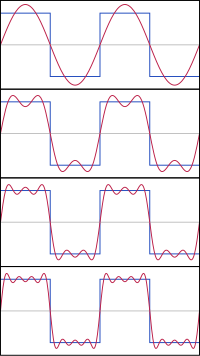

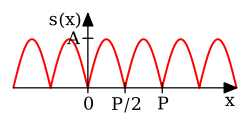
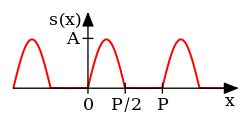

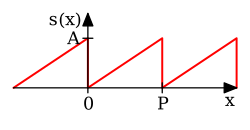
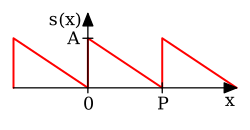





 3rd. Prentice Hall. 1996: 291. ISBN 978-0-13-373762-2.
3rd. Prentice Hall. 1996: 291. ISBN 978-0-13-373762-2.
 3rd. New York: McGraw-Hill, Inc. 1976. ISBN 0-07-054235-X.
3rd. New York: McGraw-Hill, Inc. 1976. ISBN 0-07-054235-X.

![{\displaystyle [0,P]}](https://wikimedia.org/api/rest_v1/media/math/render/svg/e22a95e69fea5905acab328644408c110eedea0e)










![{\displaystyle [-P/2,P/2]}](https://wikimedia.org/api/rest_v1/media/math/render/svg/773e3d42ef176524eeb449749ec2bc0a83b5566a)






































![{\displaystyle [-\pi ,\pi ]}](https://wikimedia.org/api/rest_v1/media/math/render/svg/cb064fd6c55820cfa660eabeeda0f6e3c4935ae6)






![{\displaystyle [x_{0},\ x_{0}+P]}](https://wikimedia.org/api/rest_v1/media/math/render/svg/46ad7364478493807dcae901dc0091bb7b6ff0fa)




![{\displaystyle [x_{0},x_{0}+P]}](https://wikimedia.org/api/rest_v1/media/math/render/svg/3ef79a1b836ec65eacb0d2c73464996d2b7830ba)
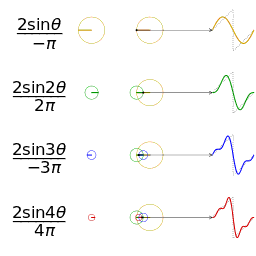
![另一个分别采用傅里叶级数的前 1, 2, 3, 4 项近似方波的可视化。(可以在这里[7]看到一个交互式的动画)](http://upload.wikimedia.org/wikipedia/commons/1/1a/Fourier_series_square_wave_circles_animation.gif)

![{\displaystyle {\hat {s}}[n]}](https://wikimedia.org/api/rest_v1/media/math/render/svg/4759449679108f08a78be5a080c3db89dc27ffea)
![{\displaystyle S[n]}](https://wikimedia.org/api/rest_v1/media/math/render/svg/0b4222b53917b43f530116997b71049100c95586)

![{\displaystyle s(x)=\sum _{n=-\infty }^{\infty }S[n]\cdot e^{i\,2\pi nx/P}\quad }](https://wikimedia.org/api/rest_v1/media/math/render/svg/92f87178156b61cc57fc94240bec5985c4ce63d2)
![{\displaystyle S(f)\ \triangleq \ \sum _{n=-\infty }^{\infty }S[n]\cdot \delta \left(f-{\frac {n}{P}}\right)}](https://wikimedia.org/api/rest_v1/media/math/render/svg/27177d458017a95aa1b728c68060767743e370db)

![{\displaystyle {\begin{aligned}{\mathcal {F}}^{-1}\{S(f)\}&=\int _{-\infty }^{\infty }\left(\sum _{n=-\infty }^{\infty }S[n]\cdot \delta \left(f-{\frac {n}{P}}\right)\right)e^{i2\pi fx}\,df\\&=\sum _{n=-\infty }^{\infty }S[n]\cdot \int _{-\infty }^{\infty }\delta \left(f-{\frac {n}{P}}\right)e^{i2\pi fx}\,df\\&=\sum _{n=-\infty }^{\infty }S[n]\cdot e^{i\,2\pi nx/P}\ \ \triangleq \ s_{\infty }(x)\end{aligned}}}](https://wikimedia.org/api/rest_v1/media/math/render/svg/c5ffcbcac13a0f7db7d5dd8c21183bb89b0d3af9)

















![{\displaystyle x\in [0,P]}](https://wikimedia.org/api/rest_v1/media/math/render/svg/7b67d1c1f507ec8b6185021d3269fc4d4103c57b)
![{\displaystyle R[n]}](https://wikimedia.org/api/rest_v1/media/math/render/svg/bd850b8b42dd52a3e6a55ac7129524e7d4af105b)


![{\displaystyle a\cdot S[n]+b\cdot R[n]}](https://wikimedia.org/api/rest_v1/media/math/render/svg/23622be4a50d54928d05c273e803240a2cb1e413)


![{\displaystyle S[-n]}](https://wikimedia.org/api/rest_v1/media/math/render/svg/ab628b28c49c04cab81d0bd30d19ee0797b0587c)

![{\displaystyle S^{*}[-n]}](https://wikimedia.org/api/rest_v1/media/math/render/svg/a3f6ea8a947b86f8a31046070359f6b8111a0bae)

![{\displaystyle S^{*}[n]}](https://wikimedia.org/api/rest_v1/media/math/render/svg/3776c67c40997d8044720ef84de7575679cf9638)

![{\displaystyle {\frac {1}{2}}(S[n]+S^{*}[-n])}](https://wikimedia.org/api/rest_v1/media/math/render/svg/2eb44dffaae6c85870914249c054e33236b02cc8)

![{\displaystyle {\frac {1}{2i}}(S[n]-S^{*}[-n])}](https://wikimedia.org/api/rest_v1/media/math/render/svg/bc039a9c12ae20a4b47337ae55bf8a7bc26d2e11)

![{\displaystyle \operatorname {Re} {(S[n])}}](https://wikimedia.org/api/rest_v1/media/math/render/svg/140ebff319eb8eb7965d0ca86dcaadb21685177a)

![{\displaystyle \operatorname {Im} {(S[n])}}](https://wikimedia.org/api/rest_v1/media/math/render/svg/0c726948120015ce0d482f5f7f4af81713342b5c)

![{\displaystyle S[n]\cdot e^{-i{\frac {2\pi }{P}}nx_{0}}}](https://wikimedia.org/api/rest_v1/media/math/render/svg/5d12b77e7a475835941ca9190940a1c6b11ff848)


![{\displaystyle S[n-n_{0}]\!}](https://wikimedia.org/api/rest_v1/media/math/render/svg/07385c0e5fd45d4e07a279a91668cf8894963e0c)












![{\displaystyle {\begin{aligned}A_{n}&={\frac {1}{\pi }}\int _{-\pi }^{\pi }s(x)\cos(nx)\,dx=0,\quad n\geq 0\\[4pt]B_{n}&={\frac {1}{\pi }}\int _{-\pi }^{\pi }s(x)\sin(nx)\,dx\\[4pt]&=-{\frac {2}{\pi n}}\cos(n\pi )+{\frac {2}{\pi ^{2}n^{2}}}\sin(n\pi )\\[4pt]&={\frac {2\,(-1)^{n+1}}{\pi n}},\quad n\geq 1\end{aligned}}}](https://wikimedia.org/api/rest_v1/media/math/render/svg/b6f5c4fb95b6f6bb17b2673b083479b652b42e32)
![{\displaystyle {\begin{aligned}s(x)&=A_{0}+\sum _{n=1}^{\infty }\left(A_{n}\cos \left(nx\right)+B_{n}\sin \left(nx\right)\right)\\[4pt]&={\frac {2}{\pi }}\sum _{n=1}^{\infty }{\frac {(-1)^{n+1}}{n}}\sin(nx),\quad \mathrm {for} \quad x-\pi \notin 2\pi \mathbb {Z} \end{aligned}}}](https://wikimedia.org/api/rest_v1/media/math/render/svg/591d6757bad021d069ecaee42fc178e9830dfbe5)




![{\displaystyle (x,y)\in [0,\pi ]\times [0,\pi ]}](https://wikimedia.org/api/rest_v1/media/math/render/svg/c18734f151b17b5d3e325f79c7000826ab832610)










![{\displaystyle {\frac {1}{2}}[x(t^{-})+x(t^{+})]}](https://wikimedia.org/api/rest_v1/media/math/render/svg/49230b01e93db8171d55b34288c6d4d8097278b3)
![{\displaystyle [0,2\pi ]}](https://wikimedia.org/api/rest_v1/media/math/render/svg/348d40bf3f8b7e1c00c4346440d7e2e4f0cc9b91)























![{\displaystyle H[n]=(S*R)[n]}](https://wikimedia.org/api/rest_v1/media/math/render/svg/74c5a5260d6ac3aac1292a8e4d4a1b4666082a8b)

![{\displaystyle H[n]=P\cdot S[n]\cdot R[n]}](https://wikimedia.org/api/rest_v1/media/math/render/svg/97c557e56479db0c1f29a2b223cb804b6c0487db)


![{\displaystyle L^{1}([0,2\pi ])}](https://wikimedia.org/api/rest_v1/media/math/render/svg/bd16426bda528c05e32e97bfba7f51b598c081b8)













![{\textstyle \lim _{|n|\to \infty }S[n]=0}](https://wikimedia.org/api/rest_v1/media/math/render/svg/7fc04d857f6462ae29422edcada981c8a798d4b5)


![{\displaystyle L^{2}([-\pi ,\pi ])}](https://wikimedia.org/api/rest_v1/media/math/render/svg/0f84fea7a212acaf14649b6cdcca282b0646a8b0)




![{\displaystyle S[n]=c_{n}}](https://wikimedia.org/api/rest_v1/media/math/render/svg/c4375307afdf29e78a31ef64b699dcb3e2fde140)






